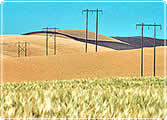Agriculture – Monoculture and Intensive Farming
 Intensive farming techniques really flourished after World War II. Agricultural production since than has probably increased by 3 or 4 times.
Intensive farming techniques really flourished after World War II. Agricultural production since than has probably increased by 3 or 4 times.
Intensive agriculture is characterised by most of the following:
- Large areas of monoculture (growing one species or crop).
- High level use of –
- Fertilisers (especially inorganic fertilisers)
- Pesticides (includes herbicides)
- Mechanisation (large tractors etc)
- Improved varieties of plants and animals
- Irrigation schemes (allows continuous cropping)
- Continuous cropping from one area year after year
- Several crops per season from the same land
- Low labour input
- Maximum yields for a minimum area of land
- Attempts to maximise profits
Many of these have negative effects on habitats and biodiversity.

1) Taking each feature above, suggest positive and negative impacts. These might include benefits (local and global) to man, social changes to rural life, landscape changes, harm to local habitats or reduction in biodiversity.
Construct a table for your results. Many of these answers can be found in other sections.
2) Using information in ‘Enhancing Biodiversity’ and ‘Organic/sustainable farming’, suggest how farming practice can be modified to make it more sustainable and environmentally friendly.
Looking at Organic farming techniques will give you a good starting point.
Useful websites:
 FAO
FAO
 Organic Farming Research Institute
Organic Farming Research Institute

 Fertilisers
Fertilisers


What's your opinion?
Average rating




Not yet rated